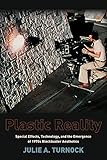Plastic reality : special effects, technology, and the emergence of 1970s blockbuster aesthetics / Julie A. Turnock.
Material type: TextSeries: Film and culturePublisher: New York : Columbia University Press, [2015]Description: xiii, 362 pages : illustrations ; 24 cmContent type:
TextSeries: Film and culturePublisher: New York : Columbia University Press, [2015]Description: xiii, 362 pages : illustrations ; 24 cmContent type: - text
- unmediated
- volume
- 9780231163521
- 0231163525
- 9780231163538
- 0231163533
- 791.43/75 23
- 791.43024 23
- PN1995.9.B598 T87 2014
| Item type | Current library | Call number | Status | Date due | Barcode | Item holds | |
|---|---|---|---|---|---|---|---|
 Book
Book
|
Karen H. Huntsman Library Main Book Collection - Second Level | 791.4375 T861p | Available | 38060007458201 |
Includes bibliographical references (pages 329-344) and index.
Optical animation : special effects compositing up to 1977 -- Before industrial light and magic : the independent Hollywood special effects business, 1968-1975 -- The expanded blockbuster : the auteurist aesthetics of 1970s special effects-driven filmmaking -- "The buck stops at opticals" : special effects technology on Star wars and Close encounters of the third kind -- A more plastic reality : the design and conception of Star wars and West Coast experimental filmmaking -- "More philosophical grey matter" : the production and aesthetic of Close encounters of the third kind -- Optical special effects into the 1980s : a well-oiled machine -- "Not-too-realistic" and intensified realistic approaches in the 1980s : traditional stop motion and showscan -- Conclusion: World-building and the legacy of 1970s special effects in contemporary cinema.
"Julie A. Turnock tracks the use and evolution of special effects in 1970s filmmaking, a development as revolutionary to film as the form's transition to sound in the 1920s. Beginning with the classical studio era's early approaches to special effects, she follows the industry's slow build toward the significant advances of the late 1960s and early 1970s, which set the stage for the groundbreaking achievements of 1977. Turnock analyzes the far-reaching impact of the convincing, absorbing, and seemingly unlimited fantasy environments of that year's iconic films, dedicating a major section of her book to the unparalleled innovations of Star wars and Close encounters of the third kind. She then traces these films' technological, cultural, and aesthetic influence into the 1980s in the deployment of optical special effects as well as the "not-too-realistic" and hyper-realistic techniques of traditional stop motion and Showscan. She concludes with a critique of special effects practices in the 2000s and their implications for the future of filmmaking and the production and experience of other visual media."--Publisher's website.
There are no comments on this title.
